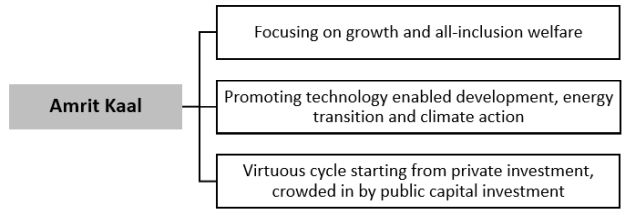Summary
On 1st February, 2022, the Finance Minister of India presented the budget for 2022 – 2023. This year's budget demonstrates a continuing effort by the Government of India towards a more sustainable resilient economy. As per the announcements made during the budget speech, the Government is considered to have formulated strategies pursuant to due consideration of various elements such as the rapid influx of technological advancements, the urgent need to address environmental concerns and the various societal issues such as protection of human rights, empowerment of communities, etc. Some of the key features of the budget include initiatives focused on inclusive growth while being in alignment with different ESG (Environmental, Social and Governance) components.
In this article, we have tried to encapsulate the key elements of this year's budget and further detail out the various sector specific strategies prescribed for an overall economic growth.
1. Introduction
With the view to emerge at the top with respect to its ESG commitment, the nation has over the last year made substantial efforts focused on implementing robust strategies and initiatives that align with the agenda to achieve sustainable growth. Moving forward, on 1st February, 2022 the Union Budget 2022 – 2023 was presented before the Lok Sabha by the Hon'ble Finance Minister, Ms. Nirmala Sitharaman. As a continuous effort from last year, the Budget 2022 – 2023 is expected to accelerate sustainable growth, promote digital economy, implement energy transition and climate action. It seeks to achieve macro-economic growth while focusing on micro-economic inclusive welfare development. Focused on capturing sector specific requirements, Budget 2022 – 2023 emphasises on the need for more employment opportunities and promoting participation of youth in various economic activities and future growth.
2. Recap of Budget 2021 – 2022 & ESG Initiatives
Drawing a parallel to last year's budget, during her speech at the Union Budget 2021-22, the Finance Minister encouraged the ESG propaganda by highlighting 6 pillars of the budget, which projected a framework of global acceptance, making India a liberal and attractive nation for trade and global supply chains passing through. The 6 pillars announced at Budget 2021 – 22 included –
- Health & well-being
- Physical & Financial Capital and Infrastructure
- Inclusive Development for Aspirational India
- Reinvigorating Human Capital
- Innovation and R&D
- Minimum Government & Maximum Governance
The underlying objective behind last year's budget was to create a space where India emerges as one of the fastest growing nations in the world to integrating a strong ESG framework across industries while aligning with the 17 UN Sustainable Development Goals.
3. . Budget 2022 – 2023: Overview
The budget this year was set in motion with the nation celebrating Azadi ka Amrit Mahotsav and entering Amrit Kaal which reflects the government's aim to fulfill vision India@100 by achieving specified milestones during the Amrit Kaal. PM Narendra Modi first used the word "Amrit Kaal" in 2021, at the 75th Independence Day celebrations, when he unveiled a unique 25-year blueprint for the country which entails –

Below are the four main elements of the Budget which include significant ESG takeaways:

3.1. PM GatiShakti –
A game-changing strategy for long-term economic growth and development, the approach is led by modern infrastructure development which includes roads, trains, airports, ports, mass transportation, waterways, and logistics. Deemed as the seven growth engines, these elements are projected to work in sync to propel the economy ahead. Additionally, complementing responsibilities of energy transmission, IT communication, bulk water & sewerage, and social infrastructure are also expected to support these engines. The strategy further involves actions like clean energy and Sabka Prayas, which promise huge jobs and entrepreneurial opportunities for all, particularly the youth. Some of the key elements under this strategy include –
1.1.1. Complete 25,000 km national highways in 2022 – 2023;
1.1.2. Provide multimodal connectivity between urban transport and railway stations;
1.1.3. Develop national ropeways development plans;
1.1.4. Popularize 'one station-one product' concept to help local businesses and supply chains;
1.1.5. The Energy Service Company (ESCO) business model will be used in large commercial buildings to accomplish energy efficiency. It will make it easier to build capacity and raise awareness for energy audits, performance contracts, and a common measurement & verification process.
1.1.6. Farmers belonging to Scheduled Castes and Scheduled Tribes, desirous of engaging in agro-forestry will also be given financial assistance.
3.2. Inclusive Development –
Recognizing the importance of Nari Shakti as a herald for an optimistic future along with women-led development initiatives, the Ministry of Women & Child Development launched the following three initiatives, namely Mission Shakti, Mission Vatsalya, Saksham Anganwadi, and Poshan 2.0, to provide women and children integrated benefits. Saksham Anganwadis constitute the new generation of anganwadis that have sufficient infrastructure and audio-visual aids powered by renewable energy. They also provide a better environment for early childhood development. Under the project, two lakh anganwadis are expected to be modernized. Some of the key elements under this strategy include –
1.1.7. To make a significant Rs. 2.37 lakh crore direct payment to 1.63 crore farmers for procurement of wheat and paddy;
1.1.8. Promote post-harvest value addition, consumption and branding of millets production;
1.1.9. Implement the Ken Betwa Link Project which is expected to benefit 9.1 lakh hectare farm land;
1.1.10. Integrate the Raising and Accelerating MSME performance (RAMP) programme with outlay of Rs. 6000 Crore to be rolled out;
1.1.11. Establish a National Digital Ecosystem for Skilling and Livelihood (DESH-Stack e-portal) to empower citizens to skill, reskill or upskill through on-line training and play a significant part in digitally empowering individuals;
1.1.12. Develop a 'National Tele Mental Health Program' to improve access to high-quality mental health counselling and treatment services;
1.1.13. In 2022-2023, 80 lakh dwellings would be built for the PM Awas Yojana's identified eligible participants, both rural and urban, with a total of Rs. 48,000 crore set aside for this purpose;
1.1.14. According to the new tax advantage, if a disabled person's parent or guardian purchases a savings life insurance policy with the disabled person as the beneficiary, the parent or guardian is eligible for a deduction from gross income before tax, subject to certain requirements.
3.3. Productivity Enhancement & Investment, Sunrise opportunities, Energy Transition, and Climate Action –
The administration lays strong emphasis on the reinforcement of 'minimal government & maximum governance', public trust and ease of doing business (EoDB), which has resulted in a drastic 25,000+ decrease in compliances and 1486 Union Laws repealed. The Amrit Kaal will be the focus of the next phase of EoDB 2.0 and Ease of Living. The government would follow the goal of 'trust-based governance' to improve the productive efficiency of capital and human resources. This new phase will be guided by the states' active participation, the digitization of manual procedures and interventions, integration of central and state-level systems via IT bridges, single-point access to all citizen-centric services, uniformity and elimination of overlapping compliances. Some of the key elements under this strategy include –
1.1.15.Allocation of Rs. 19,500 crore for Production Linked Incentive in manufacturing of high efficiency solar modules to meet the goal of 280 GW of installed solar power by 2030;
1.1.16. Five to seven per cent biomass pellets to be co-fired in thermal power plants:
- CO2 savings of 38 MMT annually
- Extra income to farmers and job opportunities to locals
- Help avoid stubble burning in agriculture fields
1.1.17. Set up four pilot projects for coal gasification and conversion of coal into chemicals for the industry;
1.1.18. Government contribution to be provided for R&D in Sunrise Opportunities like Artificial Intelligence, Geospatial Systems & Drones, Semiconductor & its eco-system, Space Economy, Genomics & Pharmaceuticals, Green Energy, and Clean Mobility Systems;
1.1.19. Private sector will be encouraged to create sustainable and innovative business models for battery and energy as a service, improving the efficiency in the electric vehicle (EV) ecosystem. A battery is the most expensive component in an EV, therefore, replacing it, will allow companies to lease or subscribe to it as a service, lowering the cost of owning and operating the car;
1.1.20. Launch a completely paperless, e-bill system for procurement purposes. The Finance Minister recommended a completely paperless, end-to-end online e-Bill System for use by all Central ministries for their procurements as an additional move to improve transparency and eliminate payment delays;
1.1.21. Adoption or linkage of National Generic Document Registration System (NGDRS) with the 'One-Nation One-Registration Software' to promote the option of a uniform process for registration and 'anywhere registration' of deeds & documents;
1.1.22. Enhance the scope of PARIVESH, a web based, role based workflow application developed for online submission and monitoring of the proposals submitted by the proponents for seeking Environment, Forest, Wildlife and CRZ Clearances from Central, State and district level authorities. The scope of this portal will now be expanded to enable application for all four approvals through a single form, and tracking of the process through Centralized Processing Centre-Green (CPC-Green).
3.4. Financing of investments –
In the face of current uncertainties, the goal remains to encourage both private and public investment in the country and therefore, the Finance Minister stressed upon the criticality of public investment, which is expected to lead the way, assist in maintaining flat private investment levels and demand in the coming fiscal year. To this effect, the outlay for capital expenditure in this budget has been significantly stepped up by over 35.4 per cent from INR 5.54 lakh crore in the current year to INR 7.50 lakh crore in 2022-23. This announcement reflects the government's aim of accelerating the virtuous cycle of investments and growth, especially in the context of the coronavirus pandemic. Furthermore, the government plans to issue Sovereign Green Bonds for mobilizing essential resources for green infrastructure. The proceeds from these bonds will also be deployed in public sector projects, thereby contributing towards decarbonising of the economy. Some of the key elements under this strategy include –
1.1.23. In 2022-23, allowing States a fiscal deficit of 4% of GSDP, of which 0.5% will be tied to power sector reforms;
1.1.24. Introduction of Digital Rupee by the Reserve Bank of India starting 2022-23;
1.1.25. Allocation of Rs. 1 lakh crore in 2022-23 to assist the states in catalysing overall investments in the economy: fifty-year interest free loans, over and above normal borrowings;
1.1.26. R&D Incentives for Start-ups: In view of the pandemic, FM proposed to extend the period of incorporation of eligible start-ups by one more year up to 31-3-2023 for providing tax incentives;
1.1.27. Earlier the government offered a 15% tax reduction for newly incorporated domestic manufacturing enterprises. The deadline for starting manufacture or production under section 115BAB has been extended by one year i.e. from 31.03.2023 to 31.03.2024.
4. Budget 2022 – 2023 in a nutshell
The budget is deemed to have a futuristic scope with the Government being on a continuous path to support India's journey towards becoming a more resilient economy. The key themes under the Budget 2022 – 2023 largely demonstrates the Government's focus on integrating an approach that is ESG aligned. As described above, the four major components for the year lay emphasis on –
- Enhancing capex and productivity viz. infrastructural developments, promotion of export and encouraging new businesses;
- Announcing schemes and initiatives that support inclusive and sustainable growth for the micro, small and medium enterprise (MSME) sector. Taking additional efforts to facilitate agricultural growth, skills development, affordable housing and undertaking required measures to achieve carbon neutrality;
- Facilitating ease of doing business by integrating resources that are aligned with digital advancements and accelerate technical growth;
- Taking societal elements into consideration, promoting social well-being with announcements in accessing improved healthcare services, water facilities, supplementary education in regional languages and constituting a digital university.
As per data released by the National Statistical Office, which is used as the base for curating the budget, projected that India's GDP in FY 2021 declined by 7.3% on account of the pandemic and its related restrictions. However, with the current market trends and lesser restrictions, India's GDP is estimated to be 1.3% higher than FY 2020, thus, indicating a slight growth from the pre-pandemic stage.
5. Specific initiatives and development strategies in alignment with UN SDGs
5.1. Urban development
In continuation and in the spirit of AmritKaal, the nation by the time is @ 100, nearly half of the Indian population is likely to be living in urban areas. To orderly prepare for this, urban development is of critical importance and thus, it is essential to nurture the megacities and their hinterlands to become current centres of economic growth. In the future, we are expected to re-imagine our cities as centres of sustainable living with opportunities for all. To execute such urban planning, the nation needs to steer a paradigm change. Furthermore, to develop India specific knowledge in urban planning and design, to deliver certified training in these areas, up to five existing academic institutions in different regions will be designated as centres of excellence. These centres will be provided endowment funds of ` 250 crore each to lead and improve syllabi, quality and access of urban planning courses in other institutions. The efforts announced by the Government focused on urban development which can be mapped against SDG 11 (Sustainable Development Goals), that talks about Sustainable Cities and Communities. Focused efforts on improving resource optimization and adopting green energy systems can help overcome major environmental & societal impact and accelerate the sustainability journey for the nation.
5.2. Healthcare and pharma
The pandemic reinstated a renewed sense of realisation and acceptance around mental health and well-being. Numerous studies over the past two years suggest the urgent need to address mental health, which have aggravated globally during the pandemic. The initiative to upgrade and increase the number of angadwadis in the country is deemed to create an enabling environment, which will improve accessibility and approachability by a larger section of the society. With the Har Ghar, Nal Se Jal scheme, the Government aims to eliminate/ curb communicable diseases and also address issues relating to hygiene and sanitation. Furthermore, the Government is also looking at contribution to research and development on topics like pharmaceuticals and genomics.
5.3. Infrastructure and logistics
The Government has identified 7 key engines that are expected to drive PM Gati Shakti and thus, accelerate the implementation of infrastructure development. In order to align with technological advancements, the upcoming infrastructure projects are to include data centres and energy storage systems. Particular emphasis is made on transport infrastructure and logistic sector. It is further given centre stage to avoid any delay or lack of coordination pertaining to fast delivery of such projects. The Budget also demonstrates how the Government has taken account of technological advancements and accordingly, expects the logistics sector to take a substantial leap in creating technology-led solutions, thus leveraging underlying data. This focused approach on infrastructure and logistics is in line with the SDGs, more particularly in alignment with SDG 9 – Industry, Innovation and Infrastructure. The sector plays an instrumental role in helping improve the nation's GDP and the initiatives announced around the same, reflect how the Government aims to integrate increased resources to use efficiency and adopt more environmentally sound technologies and processes to achieve more resilient, reliable and sustainable output.
5.4. Aerospace and defence
A significant budget of INR 3,853.7 bn (excluding pension) denotes an increase of 11% compared to the FY 2021–22 budget (4.6% compared to the revised estimate for FY 2021–22). The Government has also emphasised on the importance of integrating sunrise opportunities including artificial intelligence, geospatial systems, drones and semiconductors, expecting to meet the requirements of Armed Forces for future warfare. With the Government investing in innovation and developing conducive policy environment for, inter alia, industrial diversification and value addition to commodities, the efforts support the nation in achieving SDG 9 – Industry, Innovation and Infrastructure. Furthermore, advancement of these sectors will also reflect positively on SDG 13 – Climate Action on account of integration of cleaner and more sustainable processes.
5.5. Automotive
An underlying focus of the Budget this year has been creating multi-nodal connectivity and to support the same, the Government will be formulating a battery swapping policy to encourage the use of electric vehicles, improve transport network and encourage the goals of decarbonisation. Reiterating intent to reduce dependency on crude oil, major aspects of the Budget included adopting alternative energy systems such as solar power, waste to energy initiatives, etc. The renewed strategies are expected to motivate businesses engaged in delivery and car aggregation to transition to electric output into their fleet of services. This will drive up the scope of development for future growth and development.
5.6. Industrial products
One of the significant announcements pertains to the expansion of the national highways network by 25,000 kms in 2022 – 2023. The Government has further proposed a balanced approach of phasing out of import duty concessions for capital goods and machineries in sectors such as chemicals and textiles. While this approach will have short-term adverse impact of increasing capital expenditure, it will also enhance resilience in the overall supply chain besides boosting demand for the capital goods sector. Adopting the proposed approach positively, supports the propaganda under SDG 12 – Responsible Consumption and Production, which can be achieved by sound management of chemicals and all wastes throughout the lifecycle of the products, aligning with global frameworks to reduce its adverse impact on human life and the environment.
5.7. Digitization and telecommunication
The budget announced integration of the National Generic Document Registration System (NGDRS) with the 'One-Nation One-Registration Software' to promote an option for uniform process of registration and 'anywhere registration' of deeds & documents. Furthermore, to encourage effective use of land resources, the States will be encouraged to adopt the Unique Land Parcel Identification Number to facilitate IT-based management of records. These initiatives suggest effective consolidation of data, while supporting paperless processing. The schemes around digitization reflect a parallel commitment towards SDG 12 – Responsible Consumption and Production. Focusing on the telecommunication sector, the Government will launch a scheme for design-led manufacturing to build a strong ecosystem for 5G as part of the Production Linked Incentive Scheme. Moreover, the Government aims to encourage sunrise opportunities which include artificial intelligence, geospatial systems & drones, space economy, green energy and clean mobility systems. The nation, focusing on such sunrise opportunities, demonstrates immense potential to support sustainable development and also encourage employment opportunities. The effective implementation of the prescribed scheme and opportunities, requires entering into strong partnerships, thus, setting the tone for achieving SDG 17 – Partnerships for the Goals. This constitutes an important step towards transition in sustainable development through global and collaborative effort.
5.8. Energy transition
The budget this year saw the Government making significant commitments towards sustainable development and promoting integration of strategies focused on low carbon development. An allocation of 19,500 crore is to be made for Production Linked Incentive for manufacture of high efficiency modules, with priority to fully transform manufacturing units from polysilicon to solar PV modules. Furthermore, the prospective four pilot projects for coal gasification and conversion of coal into chemicals are to be evolved technically and financially viable. The aim is to encourage policies and required legislative changes to promote agro forestry and private forestry along with provision of financial support to farmers belonging to Scheduled Castes and Scheduled Tribes, who want to take up agro-forestry.
6. Conclusion
This year, major focus is given to empowerment of different sections of the society, such as the youth, women, farmers and other indigenous communities. Formulated on the backdrop of last year's budget and in accordance with the numerous efforts undertaken by the Government since 2014, the budget lays a blueprint for effective implementation of a futuristic propaganda for development. In this article we aim to capture various strategies and initiatives that the Government intends to manifest in order to facilitate economic transformation, multimodal connectivity and incorporate strong framework to achieve desired ESG compatible goals.
This article is for information purpose only. It is not intended to constitute, and should not be taken as legal advice, or a communication intended to solicit or establish commercial motives with any. The firm shall not have any obligations or liabilities towards any acts or omission of any reader(s) consequent to any information contained herein. The readers are advised to consult competent professionals in their own judgment before acting on the basis of any information provided hereby.


